NCERT Solutions for Class 9 Science Chapter 4 Structure of the Atom
NCERT Solutions for Class 9 Science (chemistry) Chapter 4 Structure of the Atom are given below. In these solutions, we have answered all the intext and exercise questions provided in NCERT class 9 science textbook. Class 9 NCERT Solutions Science Chapter 4 provided in this article are strictly based on the CBSE syllabus and curriculum. Students can easily download these solutions in PDF format for free from our app.
Class 9 Science Chapter 4 Textbook Questions and Answers
Intext Questions
Page No – 47
Question 1: What are canal rays?
Answer: Canal rays are positively charged radiations. These rays consist of positively charged particles known as protons. They were discovered by Gold stein in 1886.
Question 2: If an atom contains one electron and one proton, will it carry any charge or not?
Answer: An electron is a negatively charged particle, whereas a proton is a positively charged particle. The magnitude of their charges is equal. Therefore, an atom containing one electron and one proton will not carry any charge. Thus, it will be a neutral atom.
PAGE NO 49
Question 1: On the basis of Thomson’s model of an atom, explain how the atom is neutral as a whole.
Answer: According to Thomson’s model of the atom, an atom consists of both negatively and positively charged particles. The negatively charged particles are embedded in the positively charged sphere. These negative and positive charges are equal in magnitude. Thus, by counterbalancing each other’s effect, they make an atom neutral.
Question 2: On the basis of Rutherford’s model of an atom, which subatomic particle is present in the nucleus of an atom?
Answer: On the basis of Rutherford’s model of an atom, protons (positively-charged particles) are present in the nucleus of an atom.
Question 3: Draw a sketch of Bohr’s model of an atom with three shells.
Answer:
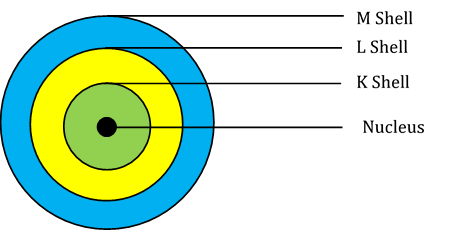
Question 4: What do you think would be the observation if the α-particle scattering experiment is carried out using a foil of a metal other than gold?
Answer: If the α-scattering experiment is carried out using a foil of a metal rather than gold, there would be no change in the observation. In the α-scattering experiment, a gold foil was taken because gold is malleable and a thin foil of gold can be easily made. It is difficult to make such foils from other metals.
PAGE NO 49
Question 1: Name the three sub-atomic particles of an atom.
Answer: The three sub-atomic particles of an atom are:
- Protons
- Electrons, and
- Neutrons
Question 2: Helium atom has an atomic mass of 4 u and two protons in its nucleus. How many neutrons does it have?
Answer: Helium atom has two neutrons. The mass of an atom is the sum of the masses of protons and neutrons present in its nucleus.
Since helium atom has two protons, mass contributed by the two protons is (2 × 1) u = 2 u. Then, the remaining mass (4 − 2) u = 2 u is contributed by 2u /1u = 2 neutrons.
PAGE NO 50
Question 1: Write the distribution of electrons in carbon and sodium atoms?
Answer: The total number of electrons in a carbon atom is 6. The distribution of electrons in carbon atom is given by:
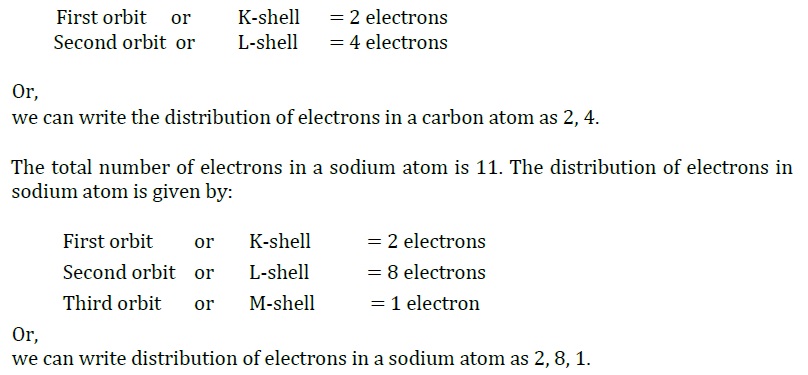
Question 2: If K and L shells of an atom are full, then what would be the total number of electrons in the atom?
Answer: The maximum number of electrons that can occupy K and L-shells of an atom are 2 and 8 respectively. Therefore, if K and L-shells of an atom are full, then the total number of electrons in the atom would be (2 + 8) = 10 electrons.
PAGE No. 52
Question 1: How will you find the valency of chlorine, sulphur and magnesium?
Answer: If the number of electrons in the outermost shell of the atom of an element is less than or equal to 4, then the valency of the element is equal to the number of electrons in the outermost shell.
On the other hand, if the number of electrons in the outermost shell of the atom of an element is greater than 4, then the valency of that element is determined by subtracting the number of electrons in the outermost shell from 8.
The distribution of electrons in chlorine, sulphur, and magnesium atoms are 2, 8, 7; 2, 8, 6 and 2, 8, 2 respectively. Therefore, the number of electrons in the outer most shell of chlorine, sulphur, and magnesium atoms are 7, 6, and 2 respectively.
Thus,
The valency of chlorine = 8 −7 = 1
The valency of sulphur = 8 − 6 = 2
The valency of magnesium = 2
PAGE NO 52
Question 1: If number of electrons in an atom is 8 and number of protons is also 8, then
(i) What is the atomic number of the atom? and
(ii) What is the charge on the atom?
Answer: (i) The atomic number is equal to the number of protons. Therefore, the atomic number of the atom is 8.
(ii) Since the number of both electrons and protons is equal, therefore, the charge on the atom is 0.
Question 2: With the help of Table 4.1, find out the mass number of oxygen and sulphur atom.
Answer: Mass number of oxygen = Number of protons + Number of neutrons
= 8 + 8
= 16
Mass number of sulphur = Number of protons + Number of neutrons
= 16 +16
= 32
Question 2: With the help of given Table, find out the mass number of oxygen and sulphur atom.
Table: Composition of Atoms of the First Eighteen Elements with Electron Distribution in Various Shells.
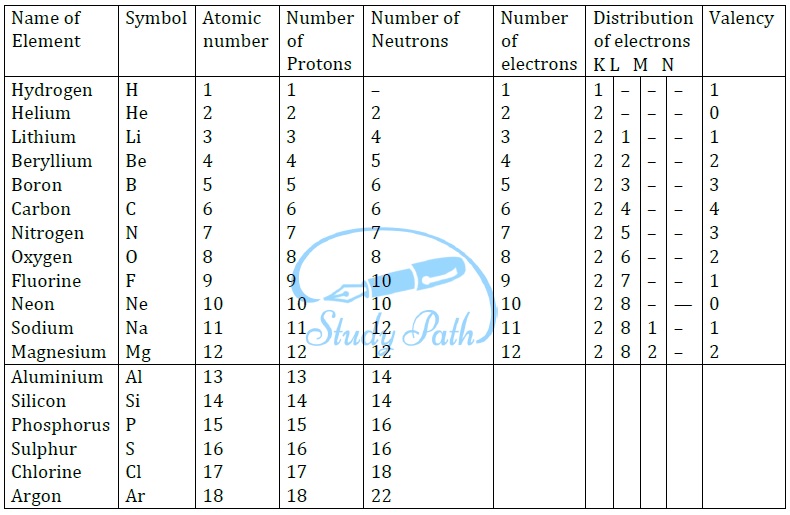
Answer: (a) To find the mass number of Oxygen:
Number of protons = 8
Number of neutrons = 8
Atomic number = 8
Atomic mass number = Number of protons + number of neutrons = 8 + 8 = 16
Therefore, mass number of oxygen = 16
(b) To find the mass number of Sulphur:
Number of protons = 16
Number of neutrons = 16
Atomic number = 16
Atomic mass number = Number of protons + number of neutrons
= 16 + 16
= 32
PAGE NO 53
Question 1: For the symbol H, D and T tabulate three sub – atomic particles found each of them.
Answer: The following table depicts the subatomic particles in Hydrogen (H), Deuterium (D), and Tritium(T).

Question 2: Write the electronic configuration of any pair of isotopes and isobars.
Answer: Isotopes: Isotopes are atoms which have the same number of protons but the number of neutrons differs. This leads to the variation in mass number too.
Two isotopes of carbon are 6𝐶12 and 6𝐶14
The electronic configuration of 6𝐶12 is 2, 4.
The electronic configuration of 6𝐶14 is 2, 4.
[Isotopes have same electronic configuration]
Isobars: Isobars are atoms which have the same mass number but differ in the atomic number. Electronic configuration of an isobar pair is as follows,
29Ca40 and 8𝐴𝑟40 are a pair of isobars of calcium.
The electronic configuration of 29Ca40 is 2, 8, 8, 2
The electronic configuration of 18𝐴𝑟40 is 2, 8, 8.
[Isobars have different electronic configuration]
EXERCISES
Question 1: Compare the properties of electrons, protons and neutrons.
Answer:
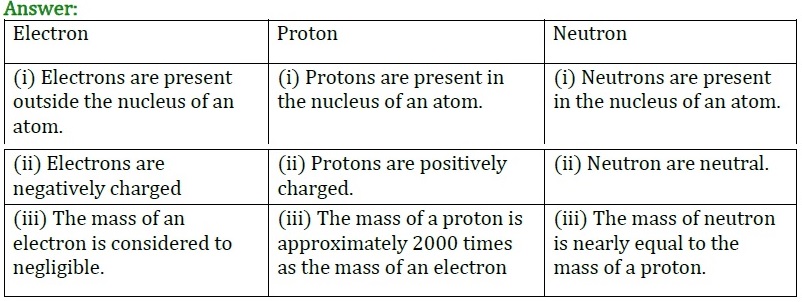
Question 2: What are the limitations of J.J. Thomson’s model of the atom?
Answer: According to J.J. Thomson’s model of an atom, an atom consists of a positively charged sphere with electrons embedded in it. However, it was later found that the positively charged particles reside at the center of the atom called the nucleus, and the electrons revolve around the nucleus.
Question 3: What are the limitations of Rutherford’s model of the atom?
Answer: According to Rutherford’s model of an atom, electrons revolve around the nucleus in fixed orbits. But, an electron revolving in circular orbits will not be stable because during revolution, it will experience acceleration. Due to acceleration, the electrons will lose energy in the form of radiation and fall into the nucleus. In such a case, the atom would be highly unstable and collapse.
Question 4: Describe Bohr’s model of the atom.
Answer: Bohr’s model of the atom Niels Bohr proposed the following postulates regarding the model of the atom.
- An atom holds the nucleus at the centre.
- Negatively charged electrons revolve around the nucleus.
- The atoms in it contains distinct orbits of electrons.
- Electrons do not radiate energy when they are in their orbits.
- The distinct orbits are named as K, L, M, N orbits. Numbers used to denote them are n=1, 2, 3, 4
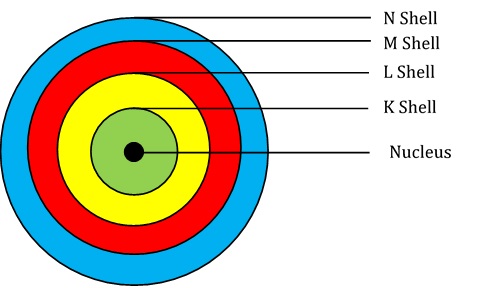
Question 5: Compare all the proposed models of an atom given in this chapter.
Answer:
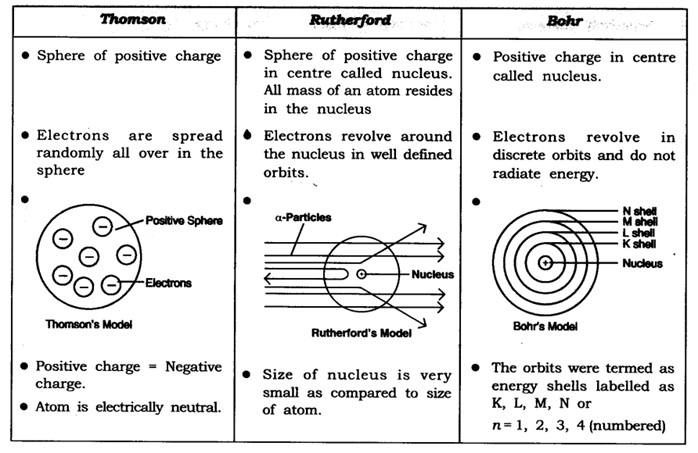
Question 6: Summarize the rules for writing of distribution of electrons in various shells for the first eighteen elements.
Answer: The rules for writing of the distribution of electrons in various shells for the first eighteen elements are given below.
(i) The maximum number of electrons that a shell can accommodate is given by the formula ‘2n2’, where ‘n’ is the orbit number or energy level index (n = 1, 2, 3…).
The maximum number of electrons present in an orbit of n = 1 is given by 2n2 = 2×12 = 2
Similarly, for second orbit, it is 2n2 = 2×22 = 8
For third orbit, it is 2n2 = 2×32 = 18
And so on……
(ii) The outermost orbit can be accommodated by a maximum number of 8 electrons.
(iii) Shells are filled with electrons in a stepwise manner i.e., the outer shell is not occupied with electrons unless the inner shells are completely filled with electrons.
Question 7: Define valency by taking examples of silicon and oxygen.
Answer: The valency of an element is the combining capacity of that element. The valency of an element is determined by the number of valence electrons present in the atom of that element.
If the number of valence electrons of the atom of an element is less than or equal to four, then the valency of that element is equal to the number of valence electrons. For example, the atom of silicon has four valence electrons.
Thus, the valency of silicon is four. On the other hand, if the number of valence electrons of the atom of an element is greater than four, then the valency of that element is obtained by subtracting the number of valence electrons from eight. For example, the atom of oxygen has six valence electrons. Thus, the valency of oxygen is (8 − 6) i.e., two.
Or
Valency is the combining capacity of an atom.
Electronic configuration of oxygen = 2 6 –
Electronic configuration of silicon =2 8 4
In the atoms of oxygen the valence electrons are 6 (i.e., electrons in the outermost shell). To fill the orbit, 2 electrons are required. In the atom of silicon, the valence electrons are 4. To fill this orbit 4 electrons are required.
Hence, the combining capacity of oxygen is 2 and of silicon is 4.
i.e., Valency of oxygen = 2
Valency of silicon = 4
Question 8: Explain with examples
(i) Atomic number,
(ii) Mass number,
(iii) Isotopes and
(iv) Isobars.
Give any two uses of isotopes.
Answer: (i) Atomic number: The atomic number of an element is the total number of protons present in the atom of that element. For example, nitrogen has 7 protons in its atom. Thus, the atomic number of nitrogen is 7.
(ii) Mass number: The mass number of an element is the sum of the number of protons and neutrons present in the atom of that element. For example, the atom of boron has 5 protons and 6 neutrons. So, the mass number of boron is 5 + 6 = 11.
(iii) Isotopes: They are atoms of the same element and have same atomic number but different mass number/atomic mass. For example: 6C12 and 6C14
(iv) Isobars: They are atoms of different elements having same mass number but different atomic number. For example: calcium, atomic number 20 and argon, atomic number 18. The number of electrons in these atoms is different, but the mass number of both these elements is 40. That is, the total number of neutrons is the same in the atoms of this pair of elements.
Two uses of isotopes are as follows:
- An isotope of uranium is used as a fuel in nuclear reactors.
- An isotope of cobalt is used in the treatment of cancer.
Question 9: Na has completely filled K and L shells. Explain.
Answer: Na has atomic number 11, so its electronic configuration is = 2, 8, 1
When it gives away its outermost shell single electron it changes to Na+ =10= 2, 8 The above configuration indicates completely filled K, L shells.
Question 10: If bromine atom is available in the form of, say, two isotopes 35𝐵𝑟79 (49.7%) and 35𝐵𝑟81 (50.3%), calculate the average atomic mass of bromine atom.
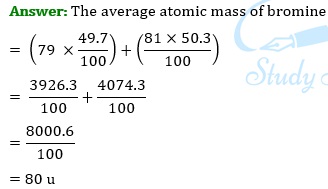
Question 11: The average atomic mass of a sample of an element X is 16.2 u. What are the percentages of isotopes 8X16 and 8X18 in the sample?
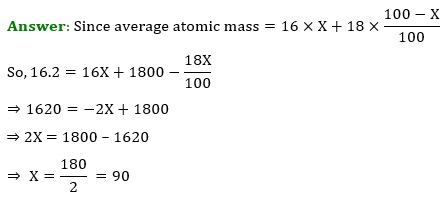
Question 12: When 90% is the X-16 sample so for X-18 sample % = 100-90=10% If Z = 3, what would be the valency of the element? Also, name the element.
Answer: By Z = 3, we mean that the atomic number of the element is 3. Its
electronic configuration is 2, 1. Hence, the valency of the element is 1 (since the
outermost shell has only one electron).
Therefore, the element with Z = 3 is lithium.
Question 13: Composition of the nuclei of two atomic species X and Y are given as under
X Y
Protons = 6 6
Neutrons = 6 8
Give the mass numbers of X and Y. What is the relation between the two species?
Answer:
Mass number of X = Number of protons + Number of neutrons
= 6 + 6
= 12
Mass number of Y = Number of protons + Number of neutrons
= 6 + 8
= 14
These two atomic species X and Y have the same atomic number, but different mass numbers. Hence, they are isotopes.
Question 14: For the following statements, write T for ‘True’ and F for ‘False’.
(a) J.J. Thomson proposed that the nucleus of an atom contains only nucleons.
(b) A neutron is formed by an electron and a proton combining together. Therefore it is neutral.
(c) The mass of an electron is about 1/2000 times that of proton.
(d) An isotope of iodine is used for making tincture iodine, which is used as a medicine.
Answer:
(a) False
(b) False
(c) True
(d) False
Put tick (√ ) against correct choice and cross ( x ) against wrong choice in the following question:
Question 15: Rutherford’s alpha-particle scattering experiment was responsible for the discovery of
(a) Atomic nucleus
(b) Electron
(c) Proton
(d) Neutron
Answer: (a) Atomic nucleus
Question 16: Isotopes of an element have
(a) the same physical properties
(b) different chemical properties
(c) different number of neutrons
(d) different atomic numbers
Answer: (c) different number of neutrons
Question 17: Number of valence electrons in Cl− ion are:
(a) 16
(b) 8
(c) 17
(d) 18
Answer: (b) 8
Question 18: Which one of the following is a correct electronic configuration of sodium?
(a) 2, 8
(b) 8, 2, 1
(c) 2, 1, 8
(d) 2, 8, 1
Answer: (d) 2, 8, 1.
Question 19: Complete the following table.
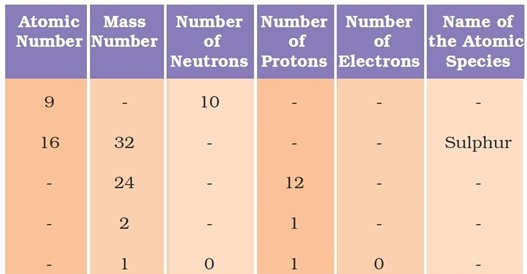
Answer:
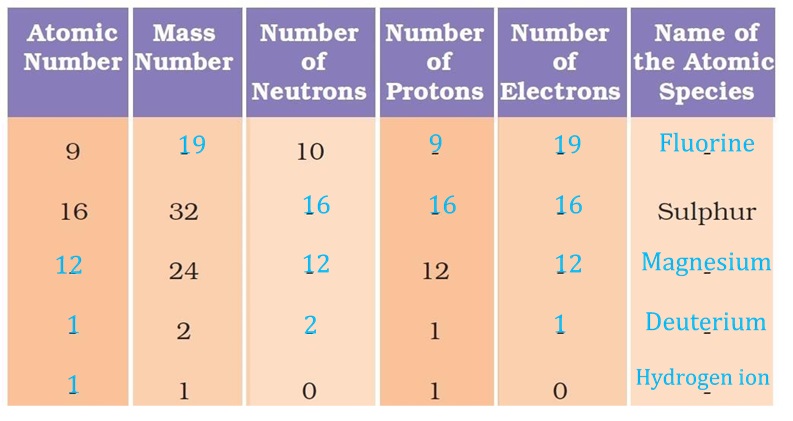
Class 9 Science NCERT Solutions Chapter 4 Structure of the Atom
CBSE Class 9 Science NCERT Solutions Chapter 4 helps students to clear their doubts and to score good marks in the board exam. All the questions are solved by experts with a detailed explanation that will help students complete their assignments & homework. Having a good grasp over CBSE NCERT Solutions for Class 9 Science will further help the students in their preparation for board exams and other competitive exams such as NTSE, Olympiad, etc.
NCERT Solutions for Class 9 Science Chapter 4 PDF
Below we have listed the topics discussed in NCERT Solutions for Class 9 Science Chapter 4. The list gives you a quick look at the different topics and subtopics of this chapter.
| Section in NCERT Book | Topics Discussed |
|---|---|
| 1.1 | Physical Nature of Matter |
| 1.2 | Characteristics of Particles of Matter |
| 1.3 | States of Matter |
| 1.4 | Can Matter Change its Shape? |
| 1.5 | Evaporation |